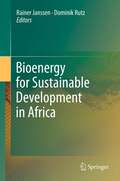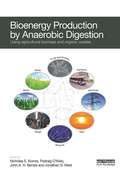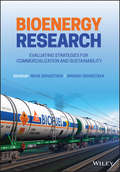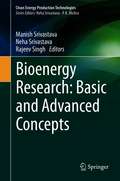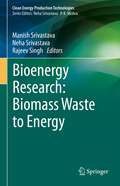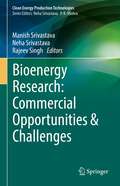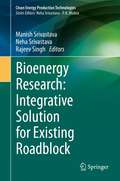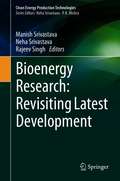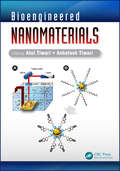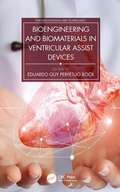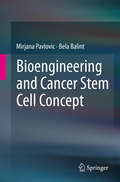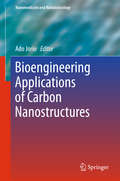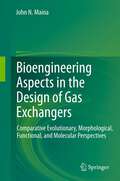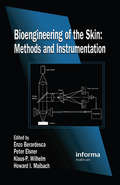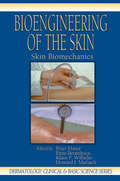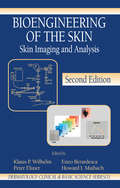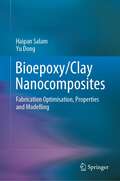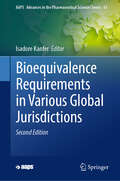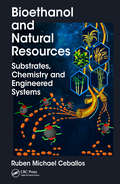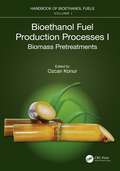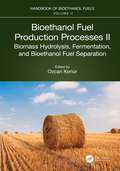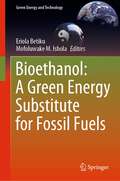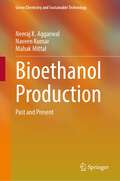- Table View
- List View
Bioenergy for Sustainable Development in Africa
by Dominik Rutz Rainer JanssenThe work builds on the results of the COMPETE Bioenergy Competence Platform for Africa, which was supported by the European Commission and coordinated by WIP Renewable Energies, Germany. The five sections cover biomass production and use, biomass technologies and markets in Africa, biomass policies, sustainability, and financial and socio-economic issues. This valuable work is, in effect, a single-source treatment of a key energy sector in a part of the world which still has a lot of unrealised potential for development.
Bioenergy from Dendromass for the Sustainable Development of Rural Areas
by Michael Bredemeier Christian Ammer Norbert Lamersdorf David Butler Manning Albrecht BemmannBased on the results of two bioenergy research initiatives in Germany, this reference examines the sustainable management of wood biomass in rural areas. The large number of participating organizations and research institutes ensures a balanced and unbiased view on the potentials and risks is presented, taking into account economic, ecological, and social aspects. Most of the results reported are available here for the first time in English and have been collated in central Europe, but are equally applicable to other temperate regions. They highlight best practices for enhancing dendromass potential and productivity, while discussing the implications on rural economies and ecosystems.
Bioenergy Production by Anaerobic Digestion: Using Agricultural Biomass and Organic Wastes (Routledge Studies in Bioenergy)
by Nicholas E. Korres Padraig O'Kiely John A.H. Benzie Jonathan S. WestInterest in anaerobic digestion (AD), the process of energy production through the production of biogas, has increased rapidly in recent years. Agricultural and other organic waste are important substrates that can be treated by AD. This book is one of the first to provide a broad introduction to anaerobic digestion and its potential to turn agricultural crops or crop residues, animal and other organic waste, into biomethane. The substrates used can include any non-woody materials, including grass and maize silage, seaweeds, municipal and industrial wastes. These are all systematically reviewed in terms of their suitability from a biological, technical and economic perspective. In the past the technical competence and high capital investment required for industrial-scale anaerobic digesters has limited their uptake, but the authors show that recent advances have made smaller-scale systems more viable through a greater understanding of optimising bacterial metabolism and productivity. Broader issues such as life cycle assessment and energy policies to promote AD are also discussed.
Bioenergy Research: Evaluating Strategies for Commercialization and Sustainability (Clean Energy Production Technologies Ser.)
by Neha SrivastavaBIOENERGY RESEARCH Evaluates challenges and sustainable solutions associated with various biofuel technologiesBioenergy Research offers an authoritative guide to recent developments in green bioenergy technologies that are currently available including: bioethanol, biobutanol, biomethanol, bio-oil, biohydrogen, biogas and biomethane. The authors provide in-depth analysis and discuss the commercial viability of the various technological advances in bioenergy. Comprehensive in scope, the book explores the environmental, practical and economic implications associated with a variety of bioenergy options. The book also considers the rollback of fossil fuels, the cost and their replacement as well as practical solutions for these issues.This important resource:Presents up-to-date research and industrial developments for various bioenergy optionsOffers comparative evaluation of bioenergy technologies for commercial feasibilityReviews current challenges and sustainable solutions for a variety of biofuel technologiesContains a review of existing strategies for bioenergy productionBioenergy Research is a valuable guide for academic researchers and industrial scientists working in the fields of biofuels and bioenergy, environmental science and technology, microbial technology, bioprocess engineering, and waste valorization.
Bioenergy Research: Basic and Advanced Concepts (Clean Energy Production Technologies)
by Manish Srivastava Neha Srivastava Rajeev SinghThis volume is first part of the five-part set on bioenergy research. This volume covers current developments and both basic and advanced concepts in bioenergy production. Based on bioenergy road map, the book will also evaluate about the ratio existing between current challenges associated and practical implementation of these biofuels. The book complies up to-date progressive development in available bioenergy options and discusses opportunities and existing risks. The main objective of the book is to provide insights into the opportunities and required actions for the development of an economically viable bioenergy industry for practical replacement of fossil fuels. This book is of interest to teachers, researchers, scientists, capacity builders and policymakers. Also the book serves as additional reading material for undergraduate and graduate students of environmental sciences. National and international bioenergy scientists, policy makers will also find this to be a useful read. Other four volumes of this set explore latest developments, commercial opportunities, waste to energy and integrated solution for bioenergy concerns.
Bioenergy Research: Biomass Waste to Energy (Clean Energy Production Technologies)
by Manish Srivastava Neha Srivastava Rajeev SinghThis volume is fourth part of the five-part set on bioenergy research. This volume covers biomass to bioenergy production concept. The book is focused on the possible and versatile biomass options available for the generation of bioenergy. Additionally, the book also explores different types of biomass for bioenergy generation at a commercial level. Further, the book elaborates on different kind of cellulose and sugar rich waste which can also be utilized for bioenergy production. It covers other relevant issues such as recent technological advancement in biomass to bioenergy conversion, waste management in the context of biomass to biofuels production technologies, green methods of energy production, alternates of fossil fuels in the near future. It also explores biomass waste valorization, utilizing microbial processes in bioenergy production. This is a useful reading material for students, researchers, industry and policy experts.Other four volumes of this set explore basic concepts, latest progress, commercial opportunities and integrated solution for bioenergy concerns.
Bioenergy Research: Commercial Opportunities & Challenges (Clean Energy Production Technologies)
by Manish Srivastava Neha Srivastava Rajeev SinghThis volume is third part of the five-part set on bioenergy research. This book provides insights into commercial advantages of commonly running bioenergy options. It explores various opportunities present at technical scale to produce biofuels. Moreover, the additional practical feasibility of the commercialization of existing biofuels including existing challenges and sustainable solutions to overcome from these technical hurdles. This Volume also focuses on the durability and long run sustainability on the new arrival of biofuels options which can be a suitable and easy replacement of currently available biofuels at pilot scale. Other four volumes of this set explore basic concepts, latest progress, bio-waste to energy conversion and integrated solution for bioenergy concerns.
Bioenergy Research: Integrative Solution for Existing Roadblock
by Manish Srivastava Neha Srivastava Rajeev SinghThis volume is fifth part of the five-part set on bioenergy research. This edited volume provides sustainable solution for all existing roadblocks in commercial bioenergy production. The book focuses on different types of obstacles involved in various bioenergy operations with detail remedy of the issue in a sustainable way. In spite of having number of potential advantages, all available bioenergy options are still far from smooth practical applicability, due to which they are still in pipeline phase to replace the fossil fuels. This book brings together the integrative approach to the readers, to connect with more viable bioenergy type on commercial scale, the existing issues and the feasible approaches to eliminate the bottlenecks in the process. Further, the book also uncovers the untouched area of bioenergy production technology by bringing forth unconventional methods, processes and parameters, which have scope to enhance biofuel production technology by “Lab to Land” methods. The book highlights aspect which are less studied or are very new in their industrial application of bioenergy production. The book presents relevant reading material for global researchers, academic institutions, research students, teachers, scientist as well as industries. Other four volumes of this set explore basic concepts, latest progress, commercial opportunities and bio-waste to energy conversion.
Bioenergy Research: Revisiting Latest Development (Clean Energy Production Technologies)
by Manish Srivastava Neha Srivastava Rajeev SinghThis volume is second part of the five-part set on bioenergy research. This book provides new insight about the latest development in bioenergy research. It presents the various bioenergy options which are further explored for practical viability, their progress and utility in the industry. The main objective of the book is to provide insights into the opportunities and required actions for the development of an economically viable bioenergy industry for practical replacement of fossil fuels. This book is of interest to teachers, researchers, scientists, capacity builders and policymakers. Also the book serves as additional reading material for undergraduate and graduate students of environmental sciences. National and international bioenergy scientists, policy makers will also find this to be a useful read. Other four volumes of this set explore basic concepts, commercial opportunities, waste to energy and integrated solution for bioenergy concerns.
Bioengineered Nanomaterials
by Atul Tlwarl Ashutosh TlwarlMany varieties of new, complex diseases are constantly being discovered, which leaves scientists with little choice but to embrace innovative methods for controlling the invasion of life-threatening problems. The use of nanotechnology has given scientists an opportunity to create nanomaterials that could help medical professionals in diagnosing and
Bioengineering and Biomaterials in Ventricular Assist Devices (Emerging Materials and Technologies)
by Eduardo Guy Perpétuo BockOften associated with artificial hearts, ventricular assist devices (VADs) are blood pumps that can provide circulatory assistance to the left ventricle, the right ventricle, or both. Bioengineering and Biomaterials in Ventricular Assist Devices reviews constructive details of VADs and the biomaterials used in their development and support. FEATURES Establishes an area of intersection between engineering and medicine Shows process development from mechanical design to automation and control Discusses biofunctional materials, tribology in ceramic biomaterials, biosensors, and surface engineering and blood This text is aimed at advanced students, researchers, and practicing engineers conducting work on VADs and will be of interest to a broad interdisciplinary group, including bioengineers, materials engineers, chemical engineers, mechanical engineers, and electrical engineers.
Bioengineering and Cancer Stem Cell Concept (SpringerBriefs in Computer Science #0)
by Bela Balint Mirjana PavlovicThis book explores the role of cancer stem cells in the diagnosis, treatment, and cure of cancers. This book also tackles novel methodology for cancer stem cell marker identification, cancer stem cell respiration and metabolism, genetic and epigenetic mechanisms including DNA methylation, and mi-RNA assemble. It also emphasizes the role of Bioinformatics techniques, which provide a novel methodology for modeling cancer outcomes. The authors investigate the difference between cancer stem cells and normal stem cells, along with the concept of targeted cancer stem cell therapy. Although the theoretical explanations of cancer stem cell involvement in leukemia and solid cancers are controversial, there is now little doubt that cancer stem cells exist within otherwise heterogeneous cancer cell population. The brief examines the two leading theories, hierarchical and the stochastic/cancer stem cell model. Researchers, professors and advanced-level students focused on bioengineering and computer science will find this book to be a valuable resource. It is a very good source of critical references for understanding of this problem, and a useful tool for professionals in related fields.
Bioengineering Applications of Carbon Nanostructures (Nanomedicine and Nanotoxicology)
by Ado JorioThis book covers the development of biotechnology based on carbon nanostructures, with a focus on nanotubes, addressing also fullerenes and amorphous carbons. The book is divided into 7 chapters, addressing tissue engineering, genetic engineering and therapy, as well as the environmental and health impacts of carbon nanostructures.
Bioengineering Aspects in the Design of Gas Exchangers: Comparative Evolutionary, Morphological, Functional, and Molecular Perspectives
by John N. MainaThis book encapsulates over three decades of the author's work on comparative functional respiratory morphology. It provides insights into the mechanism(s) by which respiratory means and processes originated and advanced to their modern states. Pertinent cross-disciplinary details and facts have been integrated and reexamined in order to arrive at more robust answers to questions regarding the basis of the functional designs of gas exchangers. The utilization of oxygen for energy production is an ancient process, the development and progression of which were underpinned by dynamic events in the biological, physical, and chemical worlds. Many books that have broached the subject of comparative functional respiratory biology have only described the form and function of the 'end-product,' the gas exchanger; they have scarcely delved into the factors and the conditions that motivated and steered the development from primeval to modern respiratory means and processes. This book addresses and answers broad questions concerning the critical synthesis of multidisciplinary data, and clarifies previously cryptic aspects of comparative respiratory biology.
Bioengineering of the Skin: Methods and Instrumentation, Volume III (Dermatology: Clinical And Basic Science Ser. #9)
by Enzo Berardesca Peter Elsner Klaus-P. Wilhelm Howard I. MaibachSkin bioengineering is an expanding field of investigative and clinical dermatology. This guide describes all commercially available techniques and instruments. It provides a thorough overview of methods for noninvasive investigation of skin function. Commercially available instruments are reviewed and compared, with updated references given for each instrument. This book offers a technical analysis of each instrument, allowing investigators to understand its biophysical principles and to make better purchases of lab instruments. Addresses of manufacturers and worldwide distributors are included, making this an essential reference source.Chapters are written by international experts. Topics include transepidermal water loss, hydration, the measurement of skin blood flow in Laser-Doppler flowetry, sebum, pH and ions, and transcutaneous pO2 and pO2 measurements. Skin color, roughness, and elasticity are examined in detail. Skin imaging techniques, capillaroscopy, and fluorescence videomicroscopy are described. Instruments for surface microscopy of the skin are also discussed.Bioengineering of the Skin explains state-of-the-art techniques and is valuable reading for anyone who needs to stay abreast of the latest activities in this ever-changing field.
Bioengineering of the Skin: Skin Biomechanics, Volume V
by Peter Elsner Enzo Berardesca Klaus P. Wilhelm Howard I. MaibachSince skin forms the interface between the human body and the environment, its mechanical properties are important in health and disease. Bioengineering of the Skin: Skin Biomechanics gives a thorough introduction in the biological basis of skin biomechanics. It explains the non-invasive methods that allow measurement of the mechanical properties o
Bioengineering of the Skin: Water and the Stratum Corneum, 2nd Edition (Dermatology: Clinical & Basic Science)
by Joachim Fluhr Peter ElsnerBioengineering of the skin, or more precisely the biophysical assessment of skin physiology, is moving rapidly from a descriptive approach to a deeper understanding of biophysical and biochemical processes. This second edition of the popular text Bioengineering of the Skin: Water and Stratum Corneum reflects the progress in the field, focusing on t
Bioengineering of the Skin: Skin Imaging & Analysis (Dermatology: Clinical & Basic Science)
by Klaus-P. Wilhelm Peter Elsner Enzo Berardesca Howard I. MaibachSpanning the many advancements that have taken place in the field since the First Edition of this book was published, this Second Edition emphasizes the imaging of the skin in its entirety, rather than focusing solely on surface layers. The Second Edition includes new chapters on technologies such as in vivo confocal laser scanning microscopy, Rama
Bioepoxy/Clay Nanocomposites: Fabrication Optimisation, Properties and Modelling
by Haipan Salam Yu DongThis book highlights current advanced developments in bioepoxy and bioepoxy/clay nanocomposites and an optimisation of material formulation and processing parameters on fabrication of bioepoxy/clay nanocomposites in order to achieve the highest mechanical properties in relation to their morphological structures, thermal properties, as well as biodegradability and water absorption, which is based on the use of Taguchi design of experiments with the consideration of technical and economical point of view. It also elaborates holistic theoretical modelling of tensile properties of such bionanocomposites with respect to the effect of contents of nanoclay fillers and epoxydised soybean oil (ESO).
Bioequivalence Requirements in Various Global Jurisdictions (AAPS Advances in the Pharmaceutical Sciences Series #61)
by Isadore KanferAn important objective of Bioequivalence Requirements in Various Global Jurisdictions is to attempt to gather current and updated information, collated in a single source, regarding the various bioequivalence and related requirements to satisfy the regulatory requirements for the market approval of multi-source (generic) drug products in various global jurisdictions. In view of the dynamic nature of regulatory requirements which are usually regularly updated, updating these requirements to remain current is an important necessity to provide such information to drug manufacturers, regulatory agencies, pharmaceutical scientists and related health organizations and governments around the world in the quest to harmonize regulatory requirements for the market approval of generic products. The revised volume includes updated information based on recent guidances and guidelines from the respective regulatory agencies as well as important trends and descriptions relating to innovative approaches for bioequivalence assessment.
Bioethanol and Natural Resources: Substrates, Chemistry and Engineered Systems
by Ruben Michael CeballosBioethanol and Natural Resources: Substrates, Chemistry and Engineered Systems provides a comprehensive review of feedstocks, physiochemical and biological pretreatments, molecular substrates, cellulolytic and ligninolytic enzymes, and advanced technologies for producing bioethanol. Although this book provides a review of first-generation bioethanol feedstocks, chemistry, and processes, there is an emphasis on second-generation "cellulosic" ethanol production. With rapid advances in biofuels technologies and the continued global dependency on unsustainable extraction of fossil fuels, this text is timely. Although it is intended to be used as a supplemental text for advanced undergraduate or graduate level courses, the book is accessible to a non-academic audience. This book provides a unique opportunity to understand bioethanol production from the basic concepts and processes to the most cutting-edge technologies under development.
Bioethanol Fuel Production Processes. I: Biomass Pretreatments
by Ozcan KonurThis book presents research on biomass pretreatments, which are a fundamental part of bioethanol fuel production to make biomass more accessible. This book also includes an introductory section on the bioethanol fuels. Bioethanol Fuel Production Processes. I: Biomass Pretreatments is the first volume in the Handbook of Bioethanol Fuels (Six-Volume Set). The primary pretreatments at the macro level are the biological chemical, hydrothermal, and mechanical pretreatments of the biomass. It also has an introductory section on the biomass pretreatments at large for bioethanol fuel production. The major pretreatments at the micro level are the enzymatic and fungal pretreatments of the biomass as the biological pretreatments, acid, alkaline, ionic liquid, and organic solvent pretreatment pretreatments of the biomass as the chemical pretreatments, steam explosion and liquid hot water pretreatments of the biomass as the hydrothermal pretreatments, and milling, ultrasonic, and microwave pretreatments of the biomass as the mechanical pretreatments. The first volume also indicates that a wide range of pretreatments stand alone or in combination with each other fractionate the biomass to its constituents of cellulose, lignin, and hemicellulose and improve both sugar and bioethanol fuel yield, making this bioethanol fuel more competitive in relation to crude oil- and natural gas-based fossil fuels. This first volume is a valuable resource for the stakeholders primarily in the research fields of energy and fuels, chemical engineering, environmental science and engineering, biotechnology, microbiology, chemistry, physics, mechanical engineering, agricultural sciences, food science and engineering, materials science, biochemistry, genetics, molecular biology, plant sciences, water resources, economics, business, management, transportation science and technology, ecology, public, environmental and occupational health, social sciences, toxicology, multidisciplinary sciences, and humanities among others.
Bioethanol Fuel Production Processes. II: Biomass Hydrolysis, Fermentation, and Bioethanol Fuel Separation
by Ozcan KonurThis book provides an overview of the research on production processes for bioethanol fuels in general, hydrolysis of the pretreated biomass for bioethanol production, microbial fermentation of hydrolysates and substrates with yeasts for bioethanol production, and separation and distillation of bioethanol fuels from the fermentation broth, complementing the research on biomass pretreatments presented in the first volume. It presents an overview of the research on biomass hydrolysis in general, wood hydrolysis, straw hydrolysis, and cellulose hydrolysis for bioethanol fuel production in the first section for biomass hydrolysis. It provides an overview of the research on microbial hydrolysate fermentation for bioethanol production in general, alternative fermentation processes for bioethanol fuel production such as simultaneous saccharification and fermentation (SSF) and consolidated biomass processing (CBP) compared with the separate hydrolysis and fermentation (SHF) process, metabolic engineering of microorganisms and substrates for bioethanol fuel production, and utilization of Saccharomyces cerevisiae for microbial fermentation of hydrolysates for bioethanol fuel production in the second section for hydrolysate fermentation. It provides an overview of the research on the bioethanol fuel separation from the fermentation broth in the last section. This book is a valuable resource for the stakeholders primarily in the research fields of energy and fuels, chemical engineering, environmental science and engineering, biotechnology, microbiology, chemistry, physics, mechanical engineering, agricultural sciences, food science and engineering, materials science, biochemistry, genetics, molecular biology, plant sciences, water resources, economics, business, management, transportations science and technology, ecology, public, environmental and occupational health, social sciences, toxicology, multidisciplinary sciences, and humanities among others.
Bioethanol: A Green Energy Substitute for Fossil Fuels (Green Energy and Technology)
by Eriola Betiku Mofoluwake M. IsholaThis book looks deeply into the prospects for using ethanol as a greener alternative to fossil fuels and the technical and scientific issues that surround them. Ethanol, with its numerous advantages, has emerged as a promising contender to replace gasoline as a fuel source. Currently, it is commercially available as a blend with gasoline, commonly known as E10 and E25, utilizing various ratios of ethanol. Despite its clear benefits over gasoline, the widespread adoption of ethanol as a fuel remains hindered by its limited availability. In this insightful book, we aim to explore the multifaceted challenges surrounding ethanol's full integration into our energy landscape, employing a comprehensive approach through review manuscripts. Leading worldwide experts, known for their deep understanding of ethanol as a fuel, have contributed to the book. Their valuable insights and contributions enrich the book's content, offering readers a comprehensive exploration of the subject matter. This book is a compelling resource for researchers, energy professionals, and anyone interested in understanding the challenges and opportunities associated with the integration of ethanol as a substitute for gasoline.
Bioethanol Production: Past and Present (Green Chemistry and Sustainable Technology)
by Neeraj K. Aggarwal Naveen Kumar Mahak MittalThis book provides the latest research on bioethanol production from first- and second- generation feedstock. Bioethanol has emerged as one of the main alternative biofuels in recent years. The book provides a perspective on the chemistry, sources and production of bioethanol highlighting the recent developments in the field.Through this book readers will learn basic and advanced bioethanol production technologies under one roof, including resource management and environmental and economic impacts. The topics discussed in the book will attract researchers and scholars focusing in this field as well as anyone who is interested in green and sustainable energy resources.
